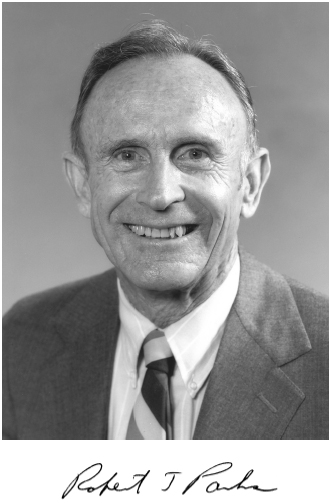
1922–2011
Elected in 1973
“For contributions in radio-inertial guidance, communications methods, systems engineering, and project management of spacecraft and missiles.”
BY JOHN L. MASON
ROBERT J. PARKS, known as Bob, was born in Los Angeles in 1922. He attended California Institute of Technology (Caltech), where he played in the backfield on the freshman football team (including one game in the Rose Bowl, Caltech’s home field) and was elected to Tau Beta Pi, the honorary engineering fraternity. He graduated with honors in 1944, with a BS degree in electrical engineering.
From February 1944 to June 1946 he served with the US Army Signal Corps, including a tour in occupied Europe. During his service, he received considerable additional schooling in electronics and radar at Harvard, the Massachusetts Institute of Technology, and the Army’s Fort Monmouth. He was discharged from the Army as a first lieutenant.
He was associated briefly with Hughes Aircraft Company in Culver City before joining the Jet Propulsion Laboratory (JPL) in 1947. His earliest work at JPL was on the guidance systems for the Army’s Corporal and Sergeant missiles. He was also responsible for projects such as Mariner 2, which made a successful Venus flyby in December 1963; Rangers 7, 8, and 9, which produced the first close-up photos of the moon, before
the Apollo lunar landing; Mariner 4, which photographed Mars in July 1965; the Surveyor lunar soft lander series, from 1966 to 1968 (including as Surveyor program manager); Mariner 5, to Venus in 1967; Mariners 6 and 7, to Mars in 1959; Mariner 9, to Mars in 1971; and Mariner 10, the first spacecraft to travel to Mercury, in 1973. In addition, he directed JPL’s efforts in support of the Viking orbiter-lander project on Mars, and the Voyager missions to Jupiter and Saturn. Recently, Voyager left our solar system and continues on….
Bob became associate director for space science and exploration, assistant laboratory director for flight projects, planetary program director, chief of the guidance division, and, in January 1984, deputy director. In this position he was responsible for the day-to-day management of JPL and for the direction of its technical, administrative, and service activities until his retirement in 1987. He was also program director for the development of the US Army’s Sergeant, a solid-propellant surface-to-surface ballistic missile.
In 1963 he received the Louis W. Hill Space Transportation Award (with Jack N. James) and the NASA Public Service Award. The Franklin Institute awarded him the Stuart Ballantine Medal in 1967, the same year that the California Air Force named him Man of the Year. NASA awarded him the Exceptional Service Medal in 1967 and the Distinguished Service Medal in 1980. He was elected a member of the National Academy of Engineering in 1973. In May of 1980, the American Institute of Aeronautics and Astronautics presented him with the Goddard Astronautics Award for “outstanding achievements and inspired leadership in his direction at JPL of flight projects from Mariner 2 to Voyager.” In 1992 he was recognized as a Distinguished Alumnus of Caltech.
Bob and Hanne Parks were members of Caltech’s Associates, a support group for Caltech. From 1998 to 2004, Bob served on the board of trustees of the Planetary Science Institute, a Tucson-based nonprofit research organization.
Bob died on June 3, 2011, of complications following injuries suffered from a fall in his home. He is survived by his wife Hanne, three sons, and three grandsons. Bob and Hanne made their home on Balboa Island, California.




